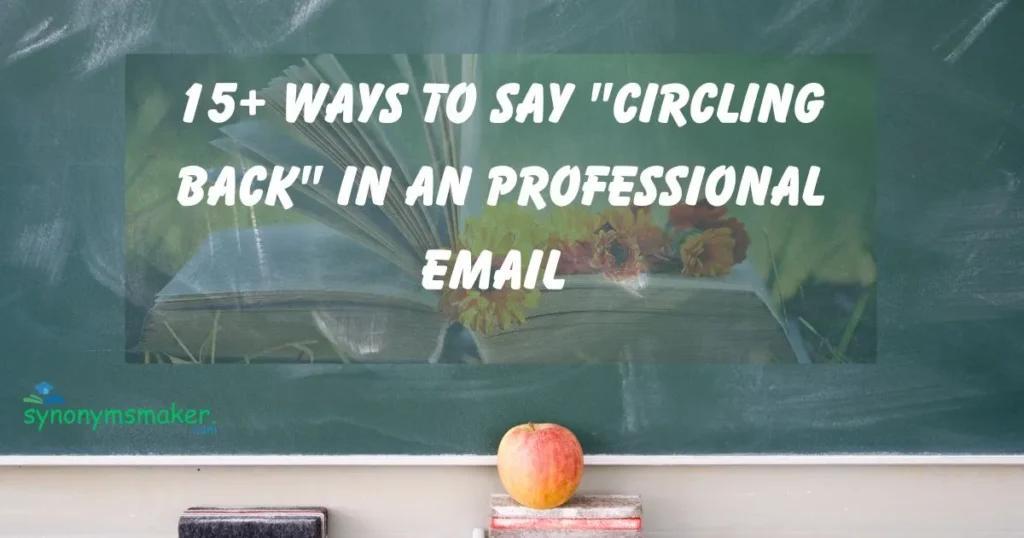Using the same email phrases like “circling back” can make your messages feel stale and forgettable especially in a fast-paced professional world where standing out matters. If you’ve ever typed Just following up or Checking in on this without thinking twice, you’re not alone. But expressions like Looping back around, Gentle reminder, or Pinging you again can start to feel overused and robotic.
By choosing more thoughtful phrases like I wanted to revisit this or Resurfacing this—you bring fresh energy and clarity to your communication. Let’s explore how saying Following up as promised or Bumping this for visibility can boost your credibility and response rate.
Circling Back Email Sample
1. Circling Back on a Job Application
Subject: Following Up on My Application
Hi [Hiring Manager’s Name],
I hope you’re doing well. I’m just circling back on my application for the [Job Title] position I submitted on [Date]. I remain very interested in the opportunity and would love to know if there’s been any progress in the hiring process.
Please let me know if you need any additional information from my side.
Best regards,
[Your Name]
2. Circling Back After a Meeting
Subject: Just Following Up
Hi [Recipient’s Name],
Just circling back on our discussion last [day] regarding [topic]. I wanted to see if there have been any updates or if you need anything further from me to move things forward.
Looking forward to your thoughts.
Thanks again,
[Your Name]
3. Circling Back on a Sales Proposal
Subject: Quick Follow-Up on Our Proposal
Hi [Client’s Name],
I wanted to circle back on the proposal I sent over last week about [brief description]. I’d be happy to walk through any questions or discuss how we can tailor it to better meet your needs.
Let me know what works best for you.
Warm regards,
[Your Name]
4. Circling Back with New Information
Subject: Update and Circling Back
Hi [Name],
I wanted to circle back with some new updates on [topic]. We’ve made progress on [brief summary], and I believe it aligns even more with your interests.
Let me know if you’d like to reconnect or discuss further.
Best regards,
[Your Name]
5. Circling Back After No Response
Subject: Following Up
Hi [Name],
Just wanted to circle back on my last message in case it got buried in your inbox. I’d love to get your thoughts on [topic] when you have a chance.
Thanks again for your time!
Warm regards,
[Your Name]
Synonyms for Circling Back in an Email
- A Quick Reminder on This
- Continuing Our Earlier Discussion
- Just Circling Back Briefly
- Reopening the Conversation
- Wanted to Recheck on This
- Revisiting This for Clarity
- Following Up on Our Conversation
- Reconnecting on This Topic
- Touching Base Again
- Revisiting Our Previous Discussion
- Checking In on Progress
- Bringing This Back to Mind
- Readdressing Our Earlier Points
- Looping Back to Our Chat
- Returning to Our Previous Email
- Following Up for Updates
- Refreshing Our Earlier Discussion
A Quick Reminder on This
In the middle of busy schedules and endless emails, it’s easy for important tasks to be overlooked or forgotten. Sending a quick reminder on this is a polite, effective, and professional way to bring attention back to a pending matter without sounding pushy or impatient. It shows you are organized, responsible, and truly respectful of the other person’s time and priorities.
This phrase fits perfectly in both formal and casual professional communication. Whether you’re waiting for feedback, approval, or a response, it keeps the tone friendly, clear, and concise, encouraging prompt action without creating pressure or discomfort.
Pairing your reminder with a short recap of the original topic or request is especially helpful. It aids the recipient’s understanding, helps avoid confusion, and speeds up the reply process. Clarity, conciseness, and respect are vital in any follow-up message.
Using a quick reminder on this helps maintain momentum while preserving professionalism and courtesy. It strikes the perfect balance between being assertive and considerate, which strengthens working relationships and fosters positive communication over time.
Continuing Our Earlier Discussion
When conversations stretch over time, it’s easy to lose track of important details and points. Saying continuing our earlier discussion is a clear, respectful way to pick up where you left off. It signals you value the ongoing dialogue, are engaged, and are eager to find solutions or clarifications.
This phrase is useful in email threads, meetings, or any form of professional communication. It shows you’re attentive, committed, and organized, reminding the other person of the prior conversation’s context and importance.
Adding a brief summary of key points or outcomes helps refresh memories, avoid misunderstandings, and ensures everyone is on the same page. It improves clarity, focus, and makes it easier for all involved to contribute meaningfully to the topic.
Using continuing our earlier discussion shows your dedication to collaboration, follow-through, and progress. It keeps the conversation moving forward with respect, professionalism, and purpose, essential for effective teamwork.
Just Circling Back Briefly
In busy work environments, things can easily get delayed, overlooked, or forgotten. Saying just circling back briefly is a gentle, polite way to nudge someone without seeming pushy or demanding. It conveys that you are checking in, respectful, and understanding of their workload.
This phrase works well in both formal and informal email follow-ups, phone calls, or meetings. It sets a friendly tone and helps keep conversations on track by reminding people of outstanding tasks, questions, or deadlines.
Pairing this phrase with a clear question or action item improves chances of a quick and focused response. It shows you value the person’s time and are mindful of their priorities.
Using just circling back briefly helps maintain good communication without adding pressure or causing frustration. It balances professionalism, empathy, and friendliness, helping relationships stay positive and productive.
Reopening the Conversation
Sometimes topics need revisiting to find better solutions, clarify points, or address new information. Saying reopening the conversation signals a willingness to explore ideas again openly and respectfully.
This phrase is useful when previous discussions ended without resolution or when updates or changes occur. It invites collaboration, shows you are proactive, and values open dialogue and transparency.
Including a quick explanation of why you’re reopening the topic helps avoid confusion and keeps communication transparent. It encourages everyone involved to engage with a fresh perspective and openness.
Using reopening the conversation fosters a culture of ongoing dialogue, problem-solving, and teamwork. It helps maintain trust, ensures important matters get the attention they deserve, and promotes continuous improvement.
Wanted to Recheck on This
Sometimes, confirmations, updates, or clarifications are needed to keep projects moving smoothly. Saying wanted to recheck on this is a polite and clear way to ask for progress or additional information without sounding impatient.
This phrase is ideal in follow-up emails, messages, or calls when you want to confirm details, timelines, or decisions. It demonstrates your attention to detail, responsibility, and commitment to accuracy.
Adding a brief reminder of the original request, deadline, or context increases clarity and helps the recipient respond effectively. It prevents misunderstandings, delays, and keeps everyone aligned.
Using wanted to recheck on this shows your professionalism, reliability, and helps keep communication open and efficient. It builds trust, ensures projects stay on track, and supports successful outcomes.
Learn More: Other Ways to Say “The Female Version of Fellow”
Revisiting This for Clarity
Sometimes conversations or projects can get complicated or confusing. Saying revisiting this for clarity shows your intention to clear up misunderstandings and ensure everyone is on the same page with clear communication.
This phrase works well in emails, meetings, or reports where detailed explanation, confirmation, or alignment is necessary. It demonstrates your dedication to accuracy, transparency, and mutual understanding.
Providing a concise summary, examples, or asking specific questions alongside this phrase helps focus the discussion and remove any doubts. It promotes open dialogue, teamwork, and better decision-making.
Using revisiting this for clarity encourages honesty, precision, and effective communication. It supports better decisions, builds stronger professional relationships, and prevents costly errors.
Following Up on Our Conversation
Following up on our conversation shows you are actively engaged and truly value the discussion you had. It lets the other person know you’re still interested and ready to move forward with the next steps. This kind of follow-up is key to keeping projects and ideas alive without overwhelming anyone.
This phrase works well in emails, calls, or meetings when you want to remind the other party of your last interaction while maintaining a professional and friendly tone. It conveys respect for their time while subtly nudging for an update or response.
Adding a brief summary of what was discussed helps reinforce the context and reminds everyone of any agreed-upon points. This approach reduces misunderstandings and helps keep the momentum going strong.
Using following up on our conversation keeps communication clear, effective, and forward-moving, showing your dedication to collaboration and results.
Reconnecting on This Topic
Reconnecting on this topic is a great way to bring fresh energy to an ongoing or paused conversation. It signals your interest in returning to the matter and finding ways to push forward or clarify things. This shows you are proactive and care about the outcome.
This phrase is perfect when some time has passed since your last interaction, and you want to refresh the discussion without pressuring the other person. It keeps the tone warm, respectful, and open to dialogue.
Including a quick recap or a new perspective can make the reconnection more meaningful and encourage renewed participation. This fosters a sense of teamwork and shared purpose.
By reconnecting on this topic, you demonstrate your commitment to effective communication, progress, and maintaining positive professional relationships.
Touching Base Again
Touching base again is a casual yet professional way to check in on the status of a task or conversation. It’s like saying, “I’m here, and I care about how things are going,” without coming across as impatient or demanding.
This phrase is especially useful in ongoing projects or collaborations where periodic updates are important. It helps maintain momentum and ensures no details get overlooked over time.
Pairing this phrase with a specific question or reminder can make it easier for the other person to respond promptly. It shows you are thoughtful about their workload and timing.
Using touching base again keeps communication lines open, friendly, and productive, building trust and respect in your working relationships.
Revisiting Our Previous Discussion
Revisiting our previous discussion signals a desire to return to earlier points that may need more thought or clarity. It’s a respectful way to ensure nothing important was missed or misunderstood.
This phrase is effective when a conversation ended without resolution or when circumstances have changed, requiring a fresh look. It encourages open-mindedness and careful review.
Using this phrase along with a brief summary of key points or questions can help clear up confusion and keep everyone aligned.
By revisiting our previous discussion, you promote accuracy, transparency, and stronger collaboration, all of which lead to better outcomes.
Checking In on Progress
Checking in on progress is an important way to stay updated and show you care about how things are moving forward. It lets your team or colleagues know you’re supportive and want to ensure that goals and deadlines are being met smoothly.
This phrase is especially useful in project management, team collaborations, or any situation where progress tracking is key. It conveys responsibility, commitment, and a willingness to help overcome any challenges.
When you check in, combining this with specific questions about status, obstacles, or next steps encourages clear and helpful responses. It also reinforces that you’re involved but not micromanaging.
Using checking in on progress keeps the conversation open, encourages accountability, and builds a collaborative spirit that drives projects to successful completion.
Bringing This Back to Mind
Bringing this back to mind is a gentle way to remind someone of an important topic or task that might have slipped their attention. It’s thoughtful, respectful, and helps prevent things from being forgotten without causing pressure.
This phrase fits well in both formal and informal communication when you want to revive focus on something important that needs action or review. It shows you are mindful, organized, and care about follow-through.
Pairing this reminder with a brief note about why it matters or what’s at stake makes it more meaningful and increases the chance of a quick and positive response.
Using bringing this back to mind strengthens communication by ensuring nothing falls through the cracks and promotes a culture of diligence, consideration, and effective teamwork.
Circling Back to Our Previous Conversation
Circling back to our previous conversation is a great way to bring attention back to important topics we’ve discussed earlier. It shows that you’re committed to following through and want to ensure nothing slips through the cracks.
This phrase works well when some time has passed or when the issue needs further clarity. It helps keep discussions focused and encourages all parties to stay on the same page.
Using this phrase signals that you value the other person’s input and are eager to keep collaboration moving smoothly. It also gently reminds them that the matter still requires attention.
By circling back to our previous conversation, you demonstrate professionalism, thoughtfulness, and a strong commitment to effective communication.
Learn More: Other Ways to Say You Can Reach Me at This Number
Touching Base on Our Last Discussion
Touching base on our last discussion is a friendly and respectful way to check in without seeming intrusive. It indicates that you’re mindful of the conversation and want to make sure progress is steady.
This phrase fits perfectly in ongoing projects, team check-ins, or client communications where regular updates matter. It keeps the tone warm, professional, and engaging.
Touching base reassures the other person that you’re present and ready to assist if needed, building stronger working relationships and trust.
Using touching base on our last discussion helps maintain momentum and ensures all parties stay aligned toward shared goals.
Revisiting Key Points from Our Talk
Revisiting key points from our talk helps bring focus back to the most important ideas and decisions made previously. It’s an effective way to clarify and solidify understanding.
This approach is especially useful after meetings or brainstorming sessions where multiple topics were covered. It prevents confusion and highlights priorities.
By emphasizing key points, you show your attentiveness and willingness to ensure everyone is clear on the next steps and responsibilities.
Using revisiting key points from our talk fosters transparency, accountability, and more productive collaboration.
Bringing Attention Back to This Matter
Bringing attention back to this matter gently reminds everyone involved that a particular issue or task still requires focus. It’s a respectful nudge that keeps important topics from being overlooked.
This phrase is ideal for situations where progress may have slowed or when follow-up is needed. It encourages timely action without sounding demanding.
By using this phrase, you highlight your awareness and dedication to seeing things through, which helps maintain project momentum.
Bringing attention back to this matter reflects a proactive mindset and strengthens communication effectiveness.
Checking Back on Our Earlier Exchange
Checking back on our earlier exchange means reviewing past communication to confirm understanding or gather updates. It shows that you’re thorough and committed to keeping everything on track.
This phrase works well when you want to reconnect after a pause or when awaiting responses. It’s polite and professional, fostering open dialogue.
Checking back helps uncover any overlooked details and keeps everyone aligned on expectations and timelines.
Using checking back on our earlier exchange builds trust, accountability, and clear, ongoing communication.
Real Life Examples and Scenario
Scenario 1: Following up on a Project Update
You sent a project proposal last week and haven’t received a response. You want to gently remind the client or colleague.
Example:
Subject: Following Up on Project Proposal
Hi [Name],
I’m touching base regarding the project proposal I shared last week. I wanted to check if you had a chance to review it and if there are any questions or feedback. Please let me know how you’d like to proceed.
Looking forward to your response.
Best,
[Your Name]
Scenario 2: Checking on a Pending Approval
You’re waiting for approval on a budget or document from your manager or client.
Example:
Subject: Checking In on Budget Approval
Dear [Manager’s Name],
Just looping back to see if there’s any update on the budget approval for the upcoming marketing campaign. I want to ensure we stay on track with the timeline. Please let me know if you need any additional information.
Thank you,
[Your Name]
Scenario 3: Reconfirming Meeting Details
You had a conversation about scheduling a meeting but haven’t received confirmation.
Example:
Subject: Reconfirming Meeting Time
Hello [Name],
I’m circling back to confirm our meeting scheduled for next Tuesday. Please let me know if the time still works for you or if you’d like to reschedule.
Best regards,
[Your Name]
Scenario 4: Following up After a Networking Event
You met a potential collaborator at a conference and want to continue the conversation.
Example:
Subject: Following Up on Our Conversation at [Event Name]
Hi [Name],
It was great meeting you at [Event Name] last week. I’m revisiting our discussion on potential partnership opportunities and would love to explore how we can collaborate further. Please let me know your availability for a quick call.
Thanks,
[Your Name]
Scenario 5: Requesting Status Update on Task Completion
You assigned a task to a team member and want to check on progress.
Example:
Subject: Checking In on Task Progress
Hi [Name],
Just bringing this back to mind regarding the report due next Friday. Could you please provide an update on your progress? Let me know if you’re facing any challenges or need support.
Best,
[Your Name]
Conclusion
In professional communication, knowing other ways to say “circling back” in an email can make your messages more engaging, polite, and effective. Whether you’re following up, checking in, or revisiting a topic, using varied phrases helps keep conversations fresh and respectful. These alternatives not only show your professionalism but also build stronger relationships by demonstrating your thoughtfulness and attention to detail.
Remember, the goal is to maintain clear, open, and friendly communication that encourages timely responses without pressure. By choosing the right phrase for your context, you create a positive impression and keep your projects and collaborations moving smoothly.
Use these phrases naturally to reflect your genuine interest and dedication, and you’ll notice better engagement and smoother workflows. Effective follow-ups are key to success in any professional setting, so keep your language clear, kind, and purposeful.

Hi, I’m Adrian Steele, the admin of synonymsmaker.com. I’m passionate about language and dedicated to providing you with the best experience in discovering synonyms and expanding your vocabulary. Feel free to share your ideas or feedback with me. I’m always open to hearing from you!



